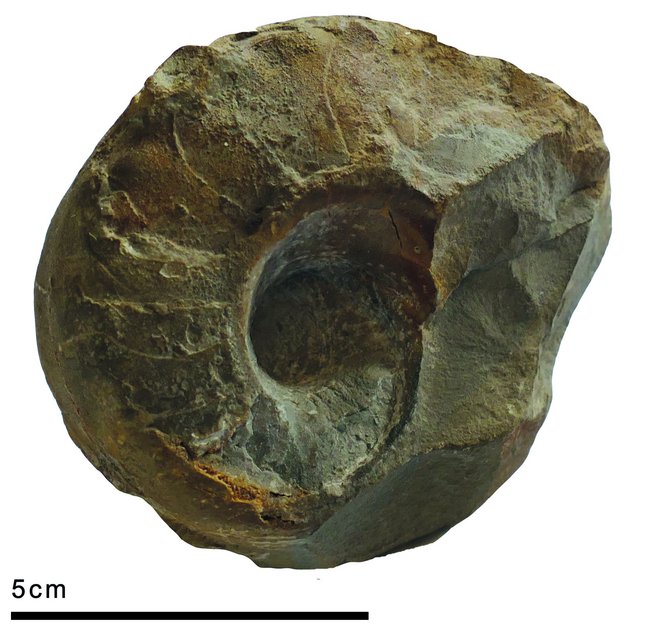The end of the Triassic period, 201 million years ago, is considered one of the greatest mass extinction events in the history of the Earth. The main cause of this catastrophe for life and evolution is thought to have been intense volcanism in Siberia. This led to worldwide climatic turbulence and acidification of the sea water. Among sea creatures, ammonites and nautilids were particularly affected. Until now, it was assumed that only a single genus of each of the two groups survived this period of crisis and that all subsequent diversity of species evolved from these two surviving lineages. This idea has now been revised due to the examination and re-evaluation of an extraordinary 185-million-year-old nautilid from the middle Early Jurassic of Behla near Donaueschingen, Germany. The fossil has been in the collection of the Stuttgart Natural History Museum since 1975. Dr. Günter Schweigert, palaeontologist at the museum, has now researched the fossil nautilus and described it in the scientific journal "Neues Jahrbuch für Geologie und Paläontologie" as a new species, Germanonautilus warthi.
Valuable new insights for the evolution of the nautilids
Nautilids are generally much rarer than those of ammonites and many fossil species are only known from chance finds. This makes the discovery of Germanonautilus warthi all the more valuable for experts. The fossil revises the evolutionary scenario at the Triassic-Jurassic boundary from the 1950s, which dates back to the American palaeontologist and nautilid researcher Bernhard Kummel (1919-1980). "The specimen clearly belongs to Germanonautilus, a genus that was widespread worldwide in the Triassic period. For a period of 15 million years, there is no evidence of Germanonautilus, but the genus, together with other nautilids, must have survived the crisis at the Triassic-Jurassic boundary somewhere," says Dr. Günter Schweigert. The new species therefore provides valuable new clues to the evolution of nautilids.
The significance of the find remained hidden for a long time
The curator in charge made the find in the 1970s during field work and classified the specimen in the collection. Since the fossil had not yet been prepared at the time, Germanonautilus warthi was thought to be a representative of Cenoceras, the genus to which almost all nautilids from the Lower Jurassic period belonged. Since Jurassic nautilids had not been scientifically revised for decades, the significance of the find remained hidden until now. "Some shell features of Germanonautilus also suggest that a quite successful family of younger Jurassic nautilids has its direct roots to this genus, but the traditional assumption that all post-Triassic nautilids go back to Cenoceras clouded this view," says Dr. Günter Schweigert.
The palaeontologist is sure that the new findings can provide valuable clues for future studies on the evolution of prehistoric and present-day marine fauna. Unlike the ammonites, the nautilids have survived until today, but are currently severely threatened by overfishing and habitat destruction.
For the editorsOriginal publication:
Schweigert, G. (2023): First record of Germanonautilus Spath, 1927 (Cephalopoda: Nautiloidea) from the Lower Jurassic (Pliensbachian) of SW Germany and its implications for the phylogeny of post-Triassic nautilids. - Neues Jahrbuch für Geologie und Paläontologie, Abhandlungen, 308(1): 79-89; Stuttgart.
DOI: https://doi.org/10.1127/njgpa/2023/1131
Published: 09.05.2023
On the naming of the new species Germanonautilus warthi:
The species name honours the finder of the specimen, the former employee of the Stuttgart Museum of Natural History, Dr. Manfred Warth.
State Museum of Natural History Stuttgart:
The State Museum of Natural History Stuttgart is a future-oriented research and communication institute. Its research collections, the archives of diversity, contain over 12 million objects. The museum researches the evolution of life and analyses the biodiversity of different ecosystems and communicates research findings to the general public.
www.naturkundemuseum-bw.de
Contact:
Dr. Günter Schweigert
State Museum of Natural History Stuttgart
Department of Palaeontology
Tel. ++49(0)711 - 89 36 - 147
E-mail: guenter.schweigert(at)smns-bw.de
Press contact:
Meike Rech
State Museum of Natural History Stuttgart
Press Officer
Tel. ++49(0)711 - 89 36 - 107
E-mail: meike.rech(at)smns-bw.de
Picture material:
Picture: Bild1_Germanonautilus warthi_SMNS_G. Schweigert.jpg
Description: Germanonautilus warthi from the Lower Jurassic Numimalis Marl Formation of Behla near Donaueschingen.
Copyright: SMNS, G. Schweigert.
Please note that his use of the image material is only permitted if the copyright notice is given. Thank you.
